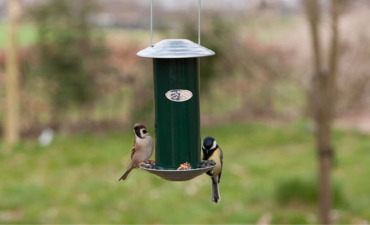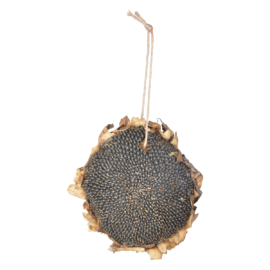Which bird eats what?
Our 'Best for Birds' and 'Wild on Wildlife' collections contain food, feeding tools and houses for birds and other garden animals. To serve the animals living in your garden, or to attract a specific bird, it's useful to know which bird eats what. To choose the right kind of food and feeding method, we make a distinction between three different types of birds.

Acrobats
It’s all in the name, these birds eat 'acrobatic', i.e. hanging and fluttering in the air. Acrobatic birds we often encounter in the gardes are for example tits and woodpeckers. They like to hang around a suet ball or peanut net. Another handy tool to attract these birds is a feeding silo. The advantage of a feeding silo is that large birds do not get a chance to hijack the food of their litte peers.
View all feeding solutions for acrobats here.
Feeding solutions for acrobats

Soil seekers
Unlike acrobats, there are also birds that prefer to eat from the ground. It is very easy to create a feeding area in an open spot in the garden. Spread the seed mix evenly over this spot. Make sure that the feeding area has escape routes / bushes nearby, so that the birds can escape quickly in dangerous situations. A feeding table on the ground is a godsend to reduce the amount of food left behind and thus vermin. Feeding tables are available one a pole and sheltered version as well.
Feeding solutions for soil seekers

Birds without preference
In addition to acrobats and soil seekers, there is another group of birds, who don't really care where they get their food from. These birds like to eat fladdering in the air but enjoy their meal sitting on the ground as well. It just depends on what’s around. The sparrow is a well-known example of an ‘omnivore’ in the Dutch garden.
Feeding solutions for birds without preference
Did you know?
The shape of a birds beak shows what he prefers to eat. A blackbird pulls worms out of the ground easily with its long pointed beak. A nuthatch gets insects out of the bark of a tree with its thin beak. And wit hits strong conical beak a finch cracks all seeds and kernels.
Of course it is also important to make a distinction in the different menus. For example, robins and blackbirds are both soil seekers, but their menu choice is very different.
The diagram below shows different type of birds and their food preferences.

Every bird has its own preference which makes choosing food extra fun! Pick the right food to attract your favorite bird to your garden.

Almost all (small) garden birds love mixed seeds. Think for example of tits, sparrows, but also robins, finches and wrens. The seed mixes are full of important nutrients and can be fed all year round.
Products out of the mixed seed range

Seed mix 1kg

Most (small) garden birds also love insects. In the winter period it is more difficult to find them and if they find some it’s hard to get them out of the ground. Garden birds therefore greatly take the benefit of your help. Dried insects can be spread over the feeding spot or feeding table for the soil seekers, but you can also pour them into a feeding sil. Easy as it goes. Thanks to the handy spout, dirty hands belong tot he past!
A surprisingly side effect: dried insects also attract hedgehogs to the garden!
Dried insects & related products


Dried insects

Dried mealworms

Sparrows, titmice, blackbirds and robins. Just a small list of birds that love fruit. Fresh fruit is hardly to find during cold winter months. Therefore dried fruit is a good replacement and an addition to the winter ration of these birds. Dried fruit, just like dried insects, is easy to spread on a feeding spot, or to place in a feeding silo. By the way, did you know that we also have suet balls in our collection that contain dried fruit?
Tip: Start feeding dried fruit in autumn. Especially in autumn birds look for vitamin-rich fruits. Those who start feeding in autumn often keep the birds as regular guests throughout the winter.
Dried fruits and related products


Dried berries

Suet balls with berries

Sunflower seeds are popular among many garden birds. Sunflower seeds are not only very suitable as a scattering food and thus for soil seekers, acrobatic birds are also catered for. Sunflower seeds are also suitable for use in a feeding silo, as a dried hanging variant (inside the sunflower), in a suet ball or processed in a paste.
Tip: Hang a dried sunflower in a tree or on an old tree trunk. Tree crawlers love it and move from tree to tree to collect their food.
Sunflower seed related products


Dried sunflower

Peanuts are popular among blackbirds and starlings, but tits are also avid lovers of this delicacy. Of course, peanuts are easy to spread on a feeding table or just at the feeding spot. But for acrobats like the great tit, it's nice to hang peanuts in a feeding silo, chain or peanut net.
Peanuts and related products

Peanut mesh


Birdhanger peanuts

Fat/suet balls & blocks
In winter, birds lose a lot of energy to maintain their body temperature. On a cold night they can even lose up to ten percent of their weight! Fat is a welcome extra source of energy during the cold winter months. Starlings love fat, but the most common and well-known 'fat lovers' are the Blue Tit and Great Tit.
Fat is mostly offered in the form of a fat ball. However, we offer many alternatives to the traditional fat ball. Have you ever thought of a fat ball? The fat block is presented in a decorative holder, fitting in every garden. But the traditional fat globe is also available in numerous designs.
Peanut butter
Our bird peanut butter also contains loads of fat. Birds love it (we’ve sold more than 10 million jars)! Take a look at all our peanut butter varieties and holders here.
Suet balls, peanut butter and related products

Suet block
Help and teach your customer
Different bird, different menu. We can imagine that your customer no longer knows what to pick. In order to present the wide range of feed varieties in a clear way, we advise to use our handy promotion displays. We have a suitable solution for every type of store and every floor area. Feel free to inquire about the possibilities. Using the POS material below, you can create an eye-catcher which the customer learns what feed they need.

Combine this with different displays for, for example, peanut butter, fat balls and/or seed mixes. The displays below are just a few examples from the assortment and per product available in a quarter or half pallet version.
Displays peanut butter, suet & seed mixes

Display FB252
Our different types of bird and wildlife food are available in a basic and premium version. The premium line was born out of our desire to produce as sustainably as possible. The packaging is an environmentally friendly variant of our basic line. For all information about the basic and premium line, please click here.


















